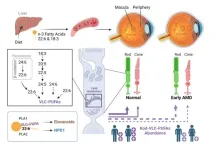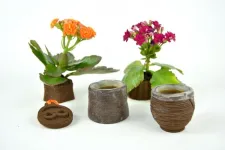(Press-News.org) The Department of Energy’s Office of Science has selected three Oak Ridge National Laboratory research teams to receive funding through DOE’s new Biopreparedness Research Virtual Environment, or BRaVE, initiative.
BRaVE, announced earlier this year, aims to build on biopreparedness research that delivered high-impact results in the fight against COVID-19. In the height of the pandemic, DOE national laboratory scientists combined fields such as biology, high-performance computing and manufacturing to bolster the national supply of personal protective equipment and improve virus testing and treatment.
“The advances made in this program will revolutionize our understanding of the science underlying a range of potential biological events and transform the nation’s ability to prepare for, and respond to, future biological threats,” said Asmeret Asefaw Berhe, Director of the DOE’s Office of Science. “Further, these advances will complement research efforts associated with other federal agencies and will be broadly applicable to understanding plant pathogens of crops that are central to DOE’s bioenergy program, as well as other biological systems.”
The initiative encourages continued collaboration across disciplines to bolster DOE’s strategy for general biopreparedness and response to biological threats. BRaVE will provide $105 million in funding across three years to support research in five focus areas.
“ORNL’s expertise and facilities provided an invaluable resource to the fight against COVID. We are thrilled to have an opportunity to lead three new projects, each composed of multidisciplinary, multi-institutional teams, that will address complex biopreparedness challenges,” said ORNL Deputy for Science and Technology Susan Hubbard. “The new projects will take advantage of the Office of Science user facilities at ORNL — the Spallation Neutron Source, the High Flux Isotope Reactor, the Center for Nanophase Materials Sciences and the Oak Ridge Leadership Computing Facility — to advance BRaVE frontiers.”
The three ORNL researchers and their teams receiving BRaVE funding are:
Heidi Hanson, group leader of the Biostatistics and Biomedical Informatics group, will lead a research team for the proposal “Data-Driven Population Health Surveillance at Scale for Pandemic readiness” in the focus area “Elucidate Multiscale Ecosystem Complexities for Robust Epidemiological Modeling.”
U.S. health data collection is largely siloed in health care institutions, making it difficult for scientists to understand disease trends. In this project, Hanson and her team will develop a large-scale epidemiological data collection tool for integrating near real-time disease information into agent-based models for biothreat scenarios.
“Understanding underlying propensities for morbidity and mortality when exposed to a previously unseen biologic agent requires large amounts of health data from a diverse population. Most data in the U.S. is siloed at single institutions, limiting our ability to make inferences at the population level,” Hanson said.
During a biothreat scenario, the envisioned tools could be used to synthesize data across multiple medical records systems and rapidly identify vulnerable populations. Researchers could then dynamically simulate health outcomes with agent-based modeling for applications such as morbidity and mortality forecasting, health care capacity planning and health care resource allocation at the national level.
The research team includes ORNL’s John Gounley, Robert Bridges, Maggie Davis, Zachary Fox, Adam Spannaus, Mayanka Chandra Shekar, Chris Stanley, Guannan Zhang, Sudip Seal and James Nutaro; Argonne National Laboratory’s Rick Stevens and Thomas Brettin; and Los Alamos National Laboratory’s Jamal Mohd-Yusof and Cristina Garcia-Cardona. The research will be conducted in collaboration with the University of Southern California, Morehouse School of Medicine, Duke University, the University of Utah and the University of Arizona.
Dean Myles, a distinguished research staff member in the Neutron Scattering Division, will lead a research team for the proposal “Accelerating Discovery Using DNP-enhanced Neutron Protein Crystallography” in the focus area “Advance Innovations in User Facility Instrumentation, Experimental Techniques, and Data Analytics.”
Neutron diffraction analysis is a highly efficient way to analyze biological systems, but most viral proteins are not compatible with this method. To overcome this hurdle and meet a need for small-molecule drug therapeutics development, Myles and his team have designed a dynamic nuclear polarization diffractometer that enhances neutron analyses to rapidly collect data from any protein, enabling faster therapeutic drug development.
The diffractometer, designed for the High Flux Isotope Reactor’s IMAGINE beamline, increases signals from hydrogen atoms, making key features in protein structures more visible for efficient characterization. The instrument reduces previous sample size requirements by a factor of 100.
“We’ll open the technique and the capability up to a much, much larger structural biology community and be able to do experiments that are currently just beyond our limits,” Myles said.
BRaVE will fund the diffractometer, 50 new-generation neutron detectors and a virtual instrument to simulate experiments with the Oak Ridge Leadership Computing Facility’s Summit and Frontier supercomputers.
The research team includes ORNL’s Huibo Cao, Lowell Crow, Dominic Giuliano, Jens Glaser, Amy Jones, Andrii Kovalevskyi, Matthew Loyd, Addi Thakur Malviya, Marshall McDonnell, Zach Morgan, Hugh O’Neill, Josh Pierce, Feiyi Wang and Guannan Zhang; ORNL-North Carolina State University’s joint faculty Flora Meilleur; Meharry Medical College’s Jamaine Davis; Fisk University’s Steven Damo; SLAC National Accelerator Laboratory’s Aina Cohen; and Argonne National Laboratory’s Andrzej Joachimiak.
Scott Retterer, a distinguished staff scientist at the Center for Nanophase Materials Sciences, will lead a research team for the proposal “Structure-guided Design of Materials to Optimize the Abiotic-Biotic Material Interface” in the focus area “Realize Understanding to Accelerate Design, Discovery, and Manufacturing of Materials.”
Scientists lack understanding about how potential pathogens interact with materials, which can lead to confusion about disease safety protocols. Retterer’s proposal aims to define the abiotic-biotic interface between materials and biological entities with the development of a multi-disciplinary workflow.
“This is all about understanding the fundamental physical and chemical interactions that occur when a pathogen like a virus, a fungus or a bacterium encounters a surface,” Retterer said. “We want to understand the cascade of physical, biological and chemical changes that occur downstream.”
The team will develop finely tuned material surfaces and employ advanced characterization tools to observe real-time interface changes while collecting biological samples and snapshots of the structure. To connect various length and time scales, researchers will use artificial intelligence and molecular dynamics modeling.
Retterer hopes to provide insights into how researchers can improve materials critical to pandemic response and develop best practices for handling sensitive biological samples during multi-institution collaborations.
The research team includes ORNL’s Rigoberto Advincula, Jack Cahill, Jan-Michael Carrillo, Liam Collins, Ben Doughty, Panchapakesan Ganesh, Rajeev Kumar, Jennifer Morrell-Falvey, Debangshu Mukherjee, Bobby Sumpter, Rama K. Vasudevan, Hanyu Wang and Alexis Williams; North Carolina Agricultural and Technical State University’s Shyam Aravamudhan, Kristen Dellinger and Leonard L. Williams; Stony Brook University’s Maya Endoh and Tad Koga; and the University of Tennessee Health Science Center’s Elizabeth Fitzpatrick.
UT-Battelle manages ORNL for DOE’s Office of Science, the single largest supporter of basic research in the physical sciences in the United States. The Office of Science is working to address some of the most pressing challenges of our time. For more information, please visit energy.gov/science. — Alexandra DeMarco
END
ORNL teams receive funding through DOE BRaVE initiative to study biopreparedness
2023-09-11
ELSE PRESS RELEASES FROM THIS DATE:
Self-reported “night owls” more likely to have unhealthy lifestyle behaviors, significantly increased diabetes risk
2023-09-11
Embargoed for release until 5:00 p.m. ET on Monday 11 September 2023
Annals of Internal Medicine Tip Sheet
@Annalsofim
Below please find summaries of new articles that will be published in the next issue of Annals of Internal Medicine. The summaries are not intended to substitute for the full articles as a source of information. This information is under strict embargo and by taking it into possession, media representatives are committing to the terms of the embargo not only on their own behalf, but also on behalf of the organization they represent.
----------------------------
1. Self-reported “night owls” more likely to have ...
Big teeth, bigger data
2023-09-11
Virginia Tech researchers in the College of Natural Resources and Environment are assessing the efficacy of shark sanctuaries by developing a modeling system that utilizes publicly accessible fishing data to determine shark catch and mortality rates. Published in the journal Science Advances, their findings represent an important step in utilizing data science to tackle oceanic conservation challenges.
“Shark sanctuaries are coastal areas designated by countries as places where the targeted ...
Article: Doctors treating patients with Parkinson’s disease must focus on stigma and emotional impacts as well as motor symptoms
2023-09-11
Even the best treatment approaches for Parkinson’s disease are inadequate if they do not address patients’ feelings of social rejection, isolation, loneliness and other psychosocial effects of stigma, according to a report from experts specializing in Parkinson’s and other movement disorders.
A new report co-authored by UCLA Health neurologist and researcher Dr. Indu Subramanian says many misconceptions and biases cause patients with Parkinson’s to be stereotyped, devalued and shunned, which, along with a progressive loss of functionality and independence, often lead to “self-stigma,” with declining self-esteem and increasing anxiety and depression. The ...
LSU Health New Orleans researchers discover a key failure in amd that may lead to progression and vision loss
2023-09-11
New Orleans, LA – Research led by Nicolas Bazan, MD, PhD, Boyd Professor, Ernest C. and Yvette C. Villere Chair for the Study of Retinal Degeneration, and Director of the Neuroscience Center of Excellence at LSU Health New Orleans School of Medicine, suggests that age-related macular degeneration (AMD) decreases an essential fatty acid, preventing the formation of a class of protective molecules and reducing repair potential. The discovery may also open new therapeutic avenues for AMD. The findings are published in Experimental Eye Research, ...
Virginia Tech has seismic role in earthquake center
2023-09-11
A Virginia Tech professor has an integral role in the establishment of a new center to study earthquakes in the Cascadia Subduction Zone off the coast of Oregon.
The project will create an earthquake center to study subduction zones — fault lines where one tectonic plate slips beneath another — to enable collaborative research and community connections for increased hazard awareness.
The Division of Earth Sciences in the Directorate for Geosciences at the National Science Foundation has awarded a $15 million grant over five years to establish the Cascadia Region ...
3D printing with coffee: Turning used grounds into caffeinated creations
2023-09-11
Coffee can do a lot of things: Wake you up, warm you up and lessen that existential dread. According to a new study, it could also help reduce the waste from 3D printing.
That’s the vision behind a new project led by Michael Rivera, an assistant professor in the ATLAS Institute and Department of Computer Science at the University of Colorado Boulder. He and his colleagues have developed a method for 3D printing a wide range of objects using a paste made entirely out of old coffee grounds, water and a few other sustainable ingredients.
The team has already experimented with using coffee grounds to craft jewelry, pots for plants and even, ...
Firms address corporate scandal with lengthy codes of ethics, study shows
2023-09-11
Corporate scandals have been on the rise for the past decade.
In 2019, Strategy& (the strategy consulting business unit of PricewaterhouseCoopers) found that for the first time in the history of its annual survey, more CEOs were dismissed for ethical concerns than for poor firm performance or internal board struggles.
There has been no shortage of highly publicized scandals, including the BP oil spill in 2010, the Target data breach in 2013 and abuses of financial incentives at Wells Fargo in 2016. A number of CEOs have resigned following alleged inappropriate relations, including Brian Krzanich at Intel, Leslie Moonves at CBS, ...
Atmospheric scientists reveal much of Houston’s ozone exceedance due to air flows from the north
2023-09-11
University of Houston atmospheric science researchers have found that while local emissions play a role in the rise of ozone levels in Houston, most of the pollutants can be carried in from other regions across the country, leading to excess ozone pollution. Their findings offer insights into strategies to mitigate future ozone pollution for the region.
The research team focused on two ozone episodes in September 2021 (Sept. 6 – 11 and Sept. 23 – 26). The month of September is the typical annual ozone peak due to high temperatures, lack of rain and air circulation patterns that transport polluted air from the north.
Their analysis revealed that roughly 63% of the excess ...
Paper: Air pollution via wildfire smoke increases suicide risk in rural counties
2023-09-11
CHAMPAIGN, Ill. — Air pollution poses well-established risks to physical health, but an emerging body of research says that it may also have adverse effects on mental health. New research co-written by a University of Illinois Urbana-Champaign economist examining the relationship between air pollution via drifting wildfire smoke exposure and suicide risk found large-scale evidence that air pollution disproportionately elevates the risk of suicide among rural populations in the U.S.
Each 10% increase in airborne particulate matter in rural counties causes monthly suicide rates ...
Ecology and artificial intelligence: stronger together
2023-09-11
Many of today’s artificial intelligence systems loosely mimic the human brain. In a new paper, researchers suggest that another branch of biology — ecology — could inspire a whole new generation of AI to be more powerful, resilient, and socially responsible.
Published September 11 in Proceedings of the National Academy of Sciences, the paper argues for a synergy between AI and ecology that could both strengthen AI and help to solve complex global challenges, such as disease outbreaks, loss of biodiversity, and climate change ...








